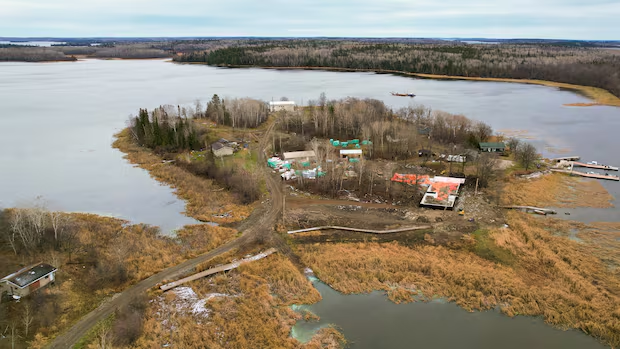First Nation in Ontario pays U.S. rates for Manitoba hydro, chief fears border tensions will boost costs

Residents of a First Nation in northwestern Ontario are paying U.S. electricity rates for power that originates from Manitoba Hydro, a situation that’s creating uncertainty amid the heated political climate.
Animakee Wa Zhing 37, formerly Northwest Angle 37, is an Anishinaabe First Nation near Sioux Narrows and has a population of around 650. The community — which consists of Regina Bay on the mainland and Windigo Island — is only accessible by water or winter road.
Windigo Island gets its electricity from the United States through an arrangement that dates back over four decades.
That system, said Chief Linda McVicar, has left her community paying among the highest hydro costs in Canada.
“It doesn’t seem right that we’re paying these rates with the exchange rate when the hydro itself is originating from Canada,” McVicar said. “I’m offended that we have to buy our power from a foreign country. It’s illogical to me.”
McVicar said that given the tenuous situation between Canada and the U.S. right now, tensions over energy, climate commitments and domestic priorities have her worried.
“When leaders in different countries are making threats on a daily basis to each other, it is concerning. I have heard Premier [Doug] Ford talk about charging tariffs to the Americans,” she said, pointing to Ford’s repeated threat to use Ontario’s energy production as a bargaining chip in negotiations.
Paying more for power from home
Manitoba Hydro generates the power that ultimately flows into Windigo Island. It sells electricity wholesale to other utilities, including Minnesota-based utility company Roseau Electric Cooperative. It does not have control over how those utilities distribute power or set rates.
The hydro company notes export sales to the United States have brought in $3.9 billion Cdn in revenue between 2010 and 2019, helping keep Manitoba rates among the lowest in North America.
Roseau Electric Cooperative in Minnesota delivers power to a meter on Brush Island in the U.S. From there, the First Nation uses its own infrastructure to bring that power across the border.
In a written statement, Minnkota Power Cooperative and Roseau Electric Cooperative emphasized that Windigo Island receives the same rates as other U.S. customers at the Northwest Angle — a part of Minnesota only accessible by land through Manitoba.
“Any additional delivery costs and the final rate charged to end-use consumers are determined by Band 37,” the statement said, referring to Animakee Wa Zhing 37 First Nation. “In the absence of any nearby grid interconnection options, this structure provides the [b]and with access to the electric system and identical rates to every other account served at the Northwest Angle.”
Linda McVicar, chief of Animakee Wa Zhing 37, says the cost of electricity on Windigo Island is becoming too much. (Laura Clementson/CBC)
According to McVicar, Windigo Island pays about 14.3 cents US per kilowatt hour, one of the highest rates in the region. Community leaders said monthly power bills — which cover 16 homes and a few community buildings — can reach as much as $30,000 Cdn during the coldest months. Per household, the bill can be as high as $1,000, she said.
By comparison, Manitoba Hydro customers pay roughly 9.6 cents Cdn per kilowatt hour, while Ontario’s time-of-use rates range from 7.6 cents during off-peak hours to 15.8 cents in on-peak hours.
Most Windigo Island residents don’t pay hydro bills directly because they simply can’t afford to, McVicar said.
“We subsidize them about $500 a month during the winter months, so $1,500 for the winter season. The rest of them are on a bill that the First Nation picks up,” she said. “We can’t pass that on to them right now. It’s definitely beyond their means. It would surpass their income.”
Efforts to improve the problem
McVicar said the cross-border setup began in the early 1980s, when Manitoba Hydro and Minnkota Power made an agreement to provide power to the Northwest Angle. From there, electricity was extended underwater to reach Windigo Island.
Indigenous Services Canada (ISC) “would have had to have knowledge at the time and have known that these things were happening,” McVicar said. “There would have had to have been infrastructure put in place to receive the hydro.”
But decades later, Windigo Island remains disconnected from Canada’s grid.
“I still can’t get past that we are a First Nation that doesn’t have — we’re not on the Canadian grid. It’s 2025,” McVicar said.
ISC said it has been working with the community to support improvements to its local power system.
In 2023, ISC provided $109,516 to fund the assessment stage of the Windigo Island Overhead Power Project, aimed at identifying code deficiencies and lighting upgrades. The construction stage was approved in July 2025.
According to the ISC, officials have met several times with McVicar and her council to discuss the First Nation’s concerns with the current electrical service to Windigo Island since 2023, with the most recent meeting this past June.
“A variety of stakeholders participate in the discussions to identify short-term and long-term options to address the First Nation’s concerns and needs, including staff from Ontario’s Ministry of Energy,” said Maryéva Métellus, a spokesperson for the department.
“ISC will continue discussions with Animakee Wa Zhing #37 and service providers concerning their electrical infrastructure and service to address their priorities and to determine next steps.”
McVicar said while those efforts are welcome, they don’t address the root issue.
“It’s appreciated, but it’s just a step,” she said. “Ultimately, I still stand by that two First Nations in the centre of Canada should be on the Canadian grid.”





